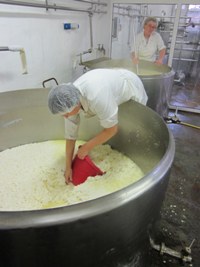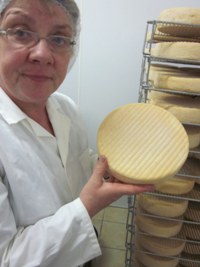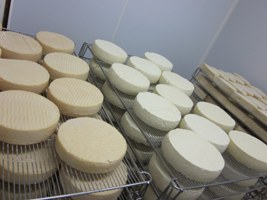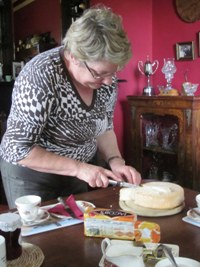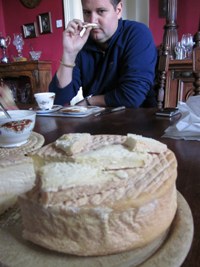Murray’s Grand Central Store Director, Will Whitlow, took a trip this October to Salone del Gusto in Northern Italy. On his trip he made a stop at Quattro Portoni, one of Italy’s premier water buffalo farms.
What comes to mind when you think of Italian cheese? The great cow’s milk cheeses like Parmigiano-Reggiano? Or the thousands of sheep milk pecorinos? Eventually you will probably think of mozzarella from the south of Italy. But is it really made from water buffalo milk? You can’t imagine how often we’re asked just that. Yes, the large, black, big-horned and wooly creatures produce astounding milk for cheesemaking.
Last week, I visited a unique farm in the province of Bergamo in Lombardy called Quattro Portoni. In the last 10 years, the Gritti brothers, Alfio and Bruno, have transformed their family’s cow dairy into one of the standout water buffalo dairies in Italy. Located in the heart of the Taleggio-making area, they were looking to distinguish their farm from those that sell milk to the big cheese plants that surround them. Bringing the southern tradition of water buffalo to the north was exactly the right choice.
Quattro Portoni, or Four Gates, is named after the 13th century gates into their moat-encircled town of Cologno al Serio. And a couple of their new, modern cheeses carry the names of those ancient, individual gates…Casatica and Moringhello. Quadrello is their spin on Taleggio, the classic cheese of their region. It’s creamy, sometimes gooey and always rich and a bit pungent. Gran Bu, the big buffalo, is just that, a physically big and big flavored firm cheese with sweet and nutty overtones.
One thousand water buffalo live on the farm. Of those, 270 are being milked for cheesemaking. Since water buffalo only give about two gallons of milk per day (cows can give up to four gallons), it takes many more water buffalo to have enough milk for a thriving cheese business. Everything from breeding to calving happens on the Quattro Portoni farm, and most of the crops they feed the buffalo are grown there too, with the addition of some of the spent barley from the beer producer down the road. Theirs is a fairly self-sustainable operation.
The day of my visit, the pristinely clean and shiny cheesemaking room was busy with 2 cheesemakers and 4 helpers making Blu di Bufala, their cube-shaped blue with light veining, a rich, fatty mouthfeel and a minerally tang at the finish. The buffalo had been milked at 4pm the previous day and 4am that morning. The milk from both milkings was pasteurized and in the vat by 6am. They work in three small open vats because buffalo milk is a bit more delicate and feeble than cows. It’s easier on the milk to work it in small batches. The milk for Blu di Bufala is coagulated and cut in the vat, then the curds are drained on worktables (the whey is used for fresh ricotta). Once the curds have drained, they are cut into slabs about 1″x3″x8″ and layered loosely into the forms. This is a laborious task and all of the cheesemakers and helpers must work together quickly to get all of the curds into forms. Once all of the forms are full, they will rest for a few hours, be flipped twice and left to sit at room temperature overnight while gas is produced inside the “wheel” making little spaces for the blue to grow. The following day, they’ll be flipped again and brined. About 120 wheels were made from this batch and they are now aging in the farm’s temperature and humidity controlled aging rooms.
This is old-school, hands-on cheesemaking. The cheese plant down the road making 100 times more cheese has the same number of cheesemakers. Machines cannot make cheeses like those produced by Quattro Portoni.






